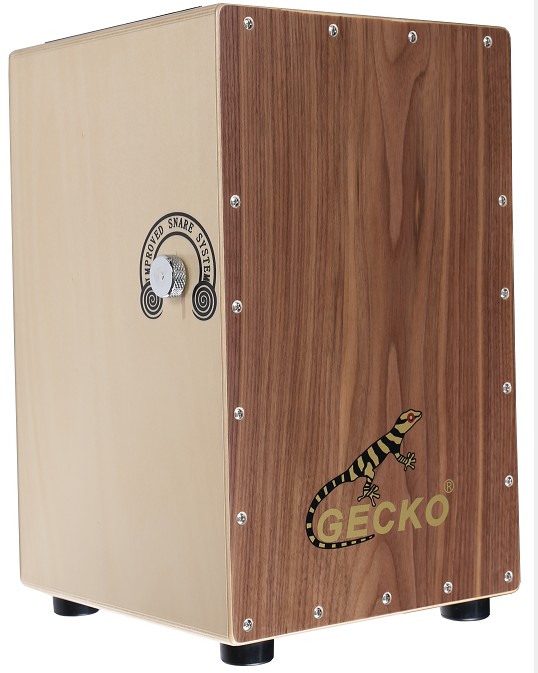CAJON long history can be traced back several centuries, with Peruvian and Cuban roots. IMHO, most drummers like us who play more modern drums are almost never asked to play Kahong drums in a performance.
One box is the entire structure of the Kahun drum. It is extremely portable during performances and can be carried anywhere in a drum bag. You must be very unfamiliar with this foreign instrument, don't worry, this kind of drum is very simple to play, you only need to master several percussion techniques and sounds, rhythm knowledge, plus a little creativity.
Someone must say that Kahun has no tactics. In fact, Kahun, like other instruments, has a variety of ways to play. Right and wrong are subjective, and you need to judge for yourself which method is most useful for you. Apply Kahun to pop music and performance
Method/Step
1. Bass stroke
This method of striking can produce the lowest pitch, which imitates the sound of the kick drum. Sit upright on Kahun, with your fingers together, your palms relaxed and flat, and placed on the surface of the drum. Straighten your back and lean forward slightly until you can reach the center of the front drumhead. Make sure you can hit freely on the entire drumhead, not just a part. After slap the drumhead once, leave quickly 2-3 cm, and then return to the original position of your body. Don't put your hands on the drum surface after slap, and quickly remove your hands to play the lowest bass without affecting the drum's resonance.
When practicing, tap a single hand slowly, one hand at a time, and then alternate left and right. Try to control the tone of the two hands to be the same.
2. Slap stroke (slap stroke)
Slap can reproduce the crisp sound of snare drums. This type of strike is characterized by high pitch and sharpness. Start with the bass slap hand type, place the base of the palm on the upper edge of Kahun, and lift the palm slightly. When playing, use the root of the palm as the fulcrum. There are two ways to slap slap: one is to relax and separate the fingers naturally. Some hands are similar to African drums, but not Konka drums. The second is to place the palm on the drum surface after slap once. This kind of percussion can create a high-pitched, very crisp sound, which is very suitable for supporting the snare drum rhythm in rock or pop music.
Just like practicing the bass slap, the movements should be slow. First, focus on the independent movements of your hands. After the movements of each hand are familiar, start playing alternately with your hands, and then switch between the bass slap and the slap.
After learning these two types of hands, we can play a variety of rock or pop rhythms. Start with some common kick and snare rhythms. In [Exercise 1], switch between the two hand types to create a steady and continuous rhythm, which is suitable for many songs, or can be improvised on this.
3. Touch stroke
The rhythm of the above two methods is very good, but don't you think something is missing? Drummers usually use hi-hats and rhythmic cymbals to match snare and kick drum rhythms. This is our next slap technique-touch slap.
The softer touch slap is very suitable for interspersed between the bass and slap slap, adding rhythm to the rhythm and helping to master the timing. Gently place your fingertips on the drum surface, anywhere below the edge of the drum.
Just like its name, touch is a light touch. Don't make a loud sound by slapped hard. The sound is small, but it is very rhythmic. When you practice on your own, you may feel that the touch is very loud, but after adding other instruments, you will feel like you have missed a few beats. This is not important, the feeling it adds to the rhythm is the most important. You can't feel it just by looking at it. You will naturally understand what I'm talking about by adding touch and tapping when you practice.
4. Open stroke
The open approach is another skill we need to master. This sound is very similar to playing Konka or African tambourine, which is higher in pitch than the bass technique, but lower than Slap. You can try the tom technique.
Place the base of the fingers close to the joints on the upper edge of Kahun, so that only the fingers touch the drum surface, and the fingers are gently together. Quickly remove your hand after one blow, just like in a bass technique. One hand at a time, and then alternate hands after getting acquainted.
5. The usage of feet
Lift your foot on the front surface of Kahun, and press the surface with your heel, about halfway through the drumhead. Keep your foot position and hit a string of open ends and you will find that the pitch is higher than usual.
Precautions
• Practice a lot!
• Study hard and practice hard!
With professional design capabilities and modern craftsmanship, GECKO Musical Instruments provides first-class products and services for music lovers all over the world. When you encounter problems with Cajon and Kalimba instruments, we welcome your calls and email consultations.
E-mail:peter@gecko-musical.com
E-mail:Jessie@gecko-musical.com
tel:+86 0752-3199063
Read more news
Video for gecko kalimba:
Post time: Jun-30-2021


